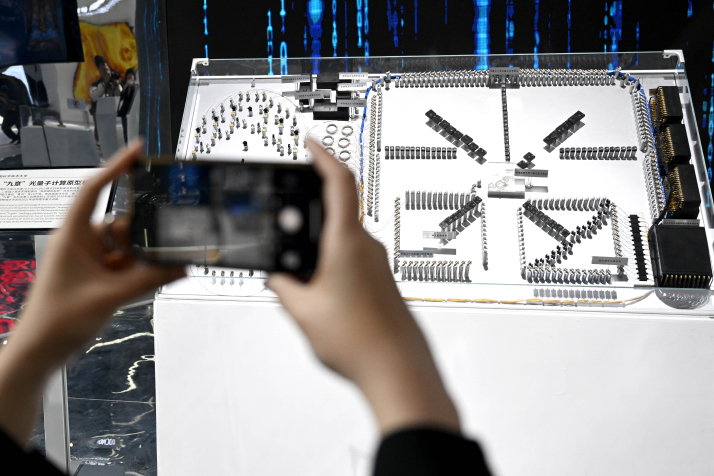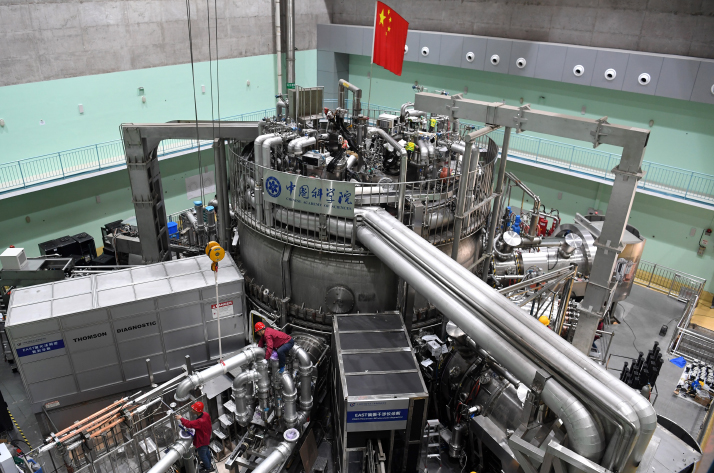| China |
| One city's actions to help bolster national strength in science and technology | |
|
|
 A visitor takes photos of a quantum computer prototype model on display at an exhibition in Hefei on April 26. The prototype was developed by researchers at the Hefei-based University of Science and Technology of China in 2020 (XINHUA)
On April 12, China's artificial Sun, officially known as the experimental advanced superconducting tokamak (EAST), achieved a steady-state high-confinement plasma operation for 403 seconds, Xinhua News Agency reported that same day. In 2017, China's artificial Sun set a world record by achieving this operation for 101 seconds. A tokamak is a machine that confines a plasma using magnetic fields in a donut shape. A steady-state high-confinement plasma operation, then, is a process during which the plasma reaches a state of high-energy confinement and produces fusion power with very hot plasmas. The EAST is located at the Institute of Plasma Physics (IPP) under the Chinese Academy of Sciences in Hefei, capital city of Anhui Province in east China. The experimental reactor's main goal is to create nuclear fusion like Sun, using deuterium (or heavy hydrogen) from the sea to provide a steady stream of clean energy. This is a recent example of China's leaping strength in sci-tech innovation over the past few decades. Last year, the country rose from 12th place in 2021 to 11th on the 2022 Global Innovation Index, remaining the only middle-income economy in the top 30. The annual index, unveiled by the World Intellectual Property Organization, ranks economies according to their innovation capacity and output. Flagship breakthroughs "We told people that we are building an artificial Sun, but that is just a metaphor for the general public to understand what we are doing," Cai Qimin, a researcher with the IPP, told Beijing Review. "Scientists don't call it that. What we are creating is something that might forever solve our energy dilemma." As opposed to fossil fuels such as coal, oil and natural gas, which are in danger of being exhausted and pose a threat to the environment, planet Earth offers an almost unlimited supply of the raw materials required by this artificial Sun, such as deuterium, he said, adding that fusion energy is considered safer and cleaner and therefore could be humanity's ideal, ultimate energy source for the future. Since entering operation in 2006, the China-designed and -developed EAST has been an open test platform for both domestic and international scientists to conduct fusion-related experiments and research, according to Cai. It is also part of the International Thermonuclear Experimental Reactor, one of the world's largest and most important international scientific research projects, and jointly funded by the European Union, China, the United States, Japan, the Republic of Korea, India and Russia. Inside the Hefei-based Anhui Innovation Center, China's first innovation-focused pavilion, flies a unique Chinese flag. In 2020, when China's Chang'e-5 robotic probe carried out its lunar mission, it broke ground by carrying a fabric-made five-starred red flag to Moon's surface. The Chang'e-5 team had spent more than a year selecting materials for the flag. During the previous Chang'e-3 and Chang'e-4 missions, the flag was painted on the spacecraft. Chinese scientists went through great efforts to find the proper materials which could withstand the harsh environment on the lunar surface and retain the flag's color and shape, Hu Shengya, a researcher with Anhui Huamao Textile Co. Ltd., who was part of the project's research and development (R&D) team, said, adding the flag weighs only 12 grams. The past decades also witnessed China's breakthroughs in quantum technology. Said technology remains a relatively new domain in the field of physics and engineering. It relies on the principles of quantum physics and mechanics. Such mechanics can be found in the physics of subatomic particles. In 2016, it launched the world's first quantum science satellite, Mozi, named after the ancient Chinese philosopher who allegedly lived in the middle-to-late fifth century B.C. Hefei, a hub for quantum technology, today houses over 20 major enterprises in the field. Origin Pilot, the first domestic quantum computer operating system in China, was developed by Origin Quantum Computing Technology Co. Ltd. and debuted in the city in 2021, making China the world's third country to accomplish this type of breakthrough. Quantum computers can perform one task extraordinarily well and at a hyper speed. Unlike traditional computers, they do not need an operating system because they do not perform multiple tasks with various goals.  Staff members perform an upgrade to China's experimental advanced superconducting tokamak (EAST), the country's artificial Sun, at the Institute of Plasma Physics under the Chinese Academy of Sciences in Hefei, Anhui Province, on April 13 (XINHUA)
Strategic support According to official statistics, Hefei's GDP exceeded 1.2 trillion yuan ($173.6 billion) in 2022, with the contribution of strategic emerging industries, such as new-energy vehicles (NEV), digital creativity and high-end equipment manufacturing, to industrial growth reaching 84 percent. A report from the Institute of Scientific and Technical Information of China showed that Hefei ranked among the top 10 Chinese cities for innovation last year. The list, unveiled by the Ministry of Science and Technology (MOST), featured 103 cities around the country. Over the past decade, Hefei has made great strides in both economic growth and industrial development. Advanced manufacturing and hi-tech technology have become the city's calling cards as it pioneers the fields of NEVs and artificial intelligence (AI), Erwin Gabardi, CEO of Volkswagen Anhui, told Beijing Review. Volkswagen Anhui is the group's first joint venture in China that wholly focuses on NEVs. Gabardi added he was thankful to the local government for creating favorable investment policies and a sound market environment for foreign enterprises. Volkswagen announced on April 18 it will further invest 1 billion euros ($1.09 billion) in the construction of an electric vehicle R&D center in Hefei. The local government has provided attractive policies to support Volkswagen Anhui to recruit and cultivate more high-caliber personnel from all over the world, Gabardi said. Local authorities have poured much effort into driving the evolution of hi-tech institutions and companies, Low Jing Xiang, a Malaysian researcher with the Hefei-based University of Science and Technology of China (USTC), told Beijing Review. For example, last year, Hefei announced the creation of the USTC Innovation Valley, which will focus on the commercialization of innovative achievements, the incubation of tech startups and the optimization of mechanisms for innovation, according to the company overseeing the valley's construction. China's leading smart speech and AI company iFlytek, for one, is building a town within the valley. The first phase of the project is scheduled to be launched by late August and completed in the first half of 2024. Upon completion, it will house the company's headquarters and fully focus on the AI industry. Talent acquisition From 2019 to 2021, sci-tech professionals overseas recognized Hefei as one of China's most attractive cities, according to a survey conducted by the Foreign Talent Research Center under the MOST. Danish scientist Stanley Lim figured traveling to Hefei would prove worthwhile professionally. "My endeavors in wide bandgap semiconductor nanotechnology match Hefei's aspirations to develop the same industry," he told Beijing Review. Lim participated in creating a wide bandgap semiconductor research center under the China-Europe Electronic Materials International Innovation Center and now serves as its director. The novel R&D institution was founded by the Hefei Municipal Government, the Administrative Committee of the Hefei Hi-Tech Zone and the Hefei Institutes of Physical Science under the Chinese Academy of Sciences. According to Zhou Zuning, Director of Human Resources at Hefei-based Gotion Hi-Tech, the third largest Chinese lithium-ion battery maker, over 10 foreigners now work in the company's headquarters in Hefei—in the R&D, international business and supply chain departments, to be specific. At present, more than 1,500 foreigners from 75 countries are working in the city. These professionals are mainly active in the integrated circuit, NEV and other key industries, according to the Hefei Science and Technology Bureau. (Print Edition Title: Hefei Aims High) Copyedited by Elsbeth van Paridon Comments to mamm@cicgamericas.com |
|
||||||||||||||||||||||||||||
|
